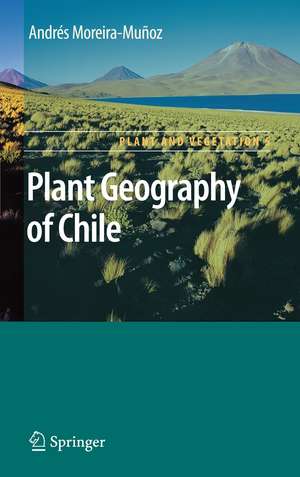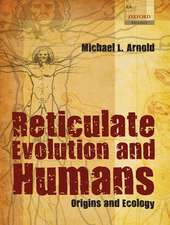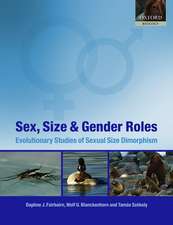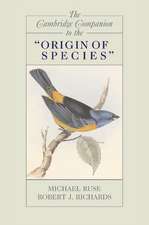Plant Geography of Chile: Plant and Vegetation, cartea 5
Autor Andres Moreira-Munozen Limba Engleză Paperback – 25 feb 2013
Focusing on three key issues – botany/systematics, geography and biogeographical analysis – this book presents a thoroughly updated synthesis both of Chilean plant geography and of the different approaches to studying it. Because of its range – from the neotropics to the temperate sub-Antarctic – Chile’s flora provides a critical insight into evolutionary patterns, particularly in relation to the distribution along the latitudinal profiles and the global geographical relationships of the country’s genera. The consequences of these relations for the evolution of the Chilean Flora are discussed.
This book will provide a valuable resource for both graduate students and researchers in botany, plant taxonomy and systematics, biogeography, evolutionary biology and plant conservation.
| Toate formatele și edițiile | Preț | Express |
|---|---|---|
| Paperback (1) | 1378.10 lei 43-57 zile | |
| SPRINGER NETHERLANDS – 25 feb 2013 | 1378.10 lei 43-57 zile | |
| Hardback (1) | 1382.51 lei 43-57 zile | |
| SPRINGER NETHERLANDS – 21 ian 2011 | 1382.51 lei 43-57 zile |
Din seria Plant and Vegetation
- 18%
 Preț: 1125.86 lei
Preț: 1125.86 lei - 24%
 Preț: 802.94 lei
Preț: 802.94 lei - 18%
 Preț: 953.52 lei
Preț: 953.52 lei - 15%
 Preț: 642.83 lei
Preț: 642.83 lei - 18%
 Preț: 954.45 lei
Preț: 954.45 lei - 24%
 Preț: 1487.38 lei
Preț: 1487.38 lei - 24%
 Preț: 1329.23 lei
Preț: 1329.23 lei - 24%
 Preț: 962.68 lei
Preț: 962.68 lei - 18%
 Preț: 1405.09 lei
Preț: 1405.09 lei - 18%
 Preț: 1122.42 lei
Preț: 1122.42 lei - 24%
 Preț: 1049.70 lei
Preț: 1049.70 lei - 18%
 Preț: 1222.01 lei
Preț: 1222.01 lei - 18%
 Preț: 1219.16 lei
Preț: 1219.16 lei - 18%
 Preț: 1230.35 lei
Preț: 1230.35 lei - 18%
 Preț: 1221.38 lei
Preț: 1221.38 lei - 18%
 Preț: 966.78 lei
Preț: 966.78 lei - 18%
 Preț: 959.19 lei
Preț: 959.19 lei
Preț: 1378.10 lei
Preț vechi: 1680.61 lei
-18% Nou
Puncte Express: 2067
Preț estimativ în valută:
263.78€ • 286.62$ • 221.72£
263.78€ • 286.62$ • 221.72£
Carte tipărită la comandă
Livrare economică 21 aprilie-05 mai
Preluare comenzi: 021 569.72.76
Specificații
ISBN-13: 9789400735040
ISBN-10: 9400735049
Pagini: 368
Ilustrații: XXII, 346 p.
Dimensiuni: 155 x 235 x 19 mm
Greutate: 0.51 kg
Ediția:2011
Editura: SPRINGER NETHERLANDS
Colecția Springer
Seria Plant and Vegetation
Locul publicării:Dordrecht, Netherlands
ISBN-10: 9400735049
Pagini: 368
Ilustrații: XXII, 346 p.
Dimensiuni: 155 x 235 x 19 mm
Greutate: 0.51 kg
Ediția:2011
Editura: SPRINGER NETHERLANDS
Colecția Springer
Seria Plant and Vegetation
Locul publicării:Dordrecht, Netherlands
Public țintă
ResearchCuprins
Part I: Geobotanical scenario.- The extravagant physical geography of Chile.- Getting geobotanical knowledge.- Part II: Chorology of Chilean Plants.- Geographical relations of the Chilean flora.- Biogeographic regionalization.- Part III: Islands biogeography.- Pacific offshore islands.- Islands on the continent.- Part IV: Case studies on selected families.- Cactaceae, a weird family and postmodern evolution.- The richest family: Chilean Asteraceae.- Nothofagus, key genus in plant geography.- Part V: Where to from here? Projections of Chilean plant geography.- All the possible worlds of biogeography.- Epilogue.- Index.
Recenzii
From the reviews:
“The book provides refreshing reading and offers ‘everything you always wanted to know about Chilean plant diversity’. It can be recommended not only to graduate students and researchers in plant biogeography, taxonomy and evolutionary biology but also to a broad audience of enthusiasts interested in South American plants.” (Jindřich Chrtek, Folia Geobotanica, Vol. 48, 2013)
“The physical geography and geobiotic history of Chile is carefully summarized … thus making Earth history easier for, say, an ecologist to understand. … the use of tracks and plentiful distribution maps does make it easier to understand and visualize the connections between floral elements globally. … I highly recommend this text for those willing to incorporate geobiotic history, physical geography, taxonomy, and bioregionalization in their biogeographical pursuits.” (Malte C. Ebach, Systematic Biology, Vol. 61 (5), 2012)
“Andrés Moreira-Muñoz has written a book on the evolutionary biogeography of Chile, from the viewpoint of plants. … I really enjoyed reading this book. It contains an impressive amount of information. … it explores different … approaches that have been proposed to explain biogeographical patterns, suggesting that the vicariance/dispersal dichotomy is just too simple a problem design to deal with the complexities of evolutionary biogeography. This book should be read by biogeographers, systematists, naturalists, ecologists, and any other person interested in biogeography and evolution.” (Juan J. Morrone, Cladistics, Vol. 28, 2012)
“The book provides refreshing reading and offers ‘everything you always wanted to know about Chilean plant diversity’. It can be recommended not only to graduate students and researchers in plant biogeography, taxonomy and evolutionary biology but also to a broad audience of enthusiasts interested in South American plants.” (Jindřich Chrtek, Folia Geobotanica, Vol. 48, 2013)
“The physical geography and geobiotic history of Chile is carefully summarized … thus making Earth history easier for, say, an ecologist to understand. … the use of tracks and plentiful distribution maps does make it easier to understand and visualize the connections between floral elements globally. … I highly recommend this text for those willing to incorporate geobiotic history, physical geography, taxonomy, and bioregionalization in their biogeographical pursuits.” (Malte C. Ebach, Systematic Biology, Vol. 61 (5), 2012)
“Andrés Moreira-Muñoz has written a book on the evolutionary biogeography of Chile, from the viewpoint of plants. … I really enjoyed reading this book. It contains an impressive amount of information. … it explores different … approaches that have been proposed to explain biogeographical patterns, suggesting that the vicariance/dispersal dichotomy is just too simple a problem design to deal with the complexities of evolutionary biogeography. This book should be read by biogeographers, systematists, naturalists, ecologists, and any other person interested in biogeography and evolution.” (Juan J. Morrone, Cladistics, Vol. 28, 2012)
Notă biografică
Andrés Moreira-Muñoz was born in Los Angeles (Chile), studied at the German School in Santiago and graduated as Professional Geographer at the Pontificia Universidad Católica de Chile. Botanical interest was inherited from his grandfa-ther and mother, both renowned botanists at the Museo Nacional de Historia Natural in Santiago. He obtained his doctoral degree in Geography from the University Erlangen-Nürnberg, Germany, under the direction of the plant geographer Prof. Michael Richter. He currently occupies a position as assistant professor at the Instituto de Geo-grafía, Pontificia Universidad Católica de Chile, and develops research projects about the chorology of Chilean plants, conservation biogeography and field-based education.
Textul de pe ultima copertă
The first and so far only Plant Geography of Chile was written about 100 years ago, since when many things have changed: plants have been renamed and reclassified; taxonomy and systematics have experienced deep changes as have biology, geography, and biogeography. The time is therefore ripe for a new look at Chile’s plants and their distribution.
Focusing on three key issues – botany/systematics, geography and biogeographical analysis – this book presents a thoroughly updated synthesis both of Chilean plant geography and of the different approaches to studying it. Because of its range – from the neotropics to the temperate sub-Antarctic – Chile’s flora provides a critical insight into evolutionary patterns, particularly in relation to the distribution along the latitudinal profiles and the global geographical relationships of the country’s genera. The consequences of these relations for the evolution of the Chilean Flora are discussed.
This book will provide a valuable resource for both graduate students and researchers in botany, plant taxonomy and systematics, biogeography, evolutionary biology and plant conservation.
Focusing on three key issues – botany/systematics, geography and biogeographical analysis – this book presents a thoroughly updated synthesis both of Chilean plant geography and of the different approaches to studying it. Because of its range – from the neotropics to the temperate sub-Antarctic – Chile’s flora provides a critical insight into evolutionary patterns, particularly in relation to the distribution along the latitudinal profiles and the global geographical relationships of the country’s genera. The consequences of these relations for the evolution of the Chilean Flora are discussed.
This book will provide a valuable resource for both graduate students and researchers in botany, plant taxonomy and systematics, biogeography, evolutionary biology and plant conservation.
Caracteristici
No comparable book is available in English - first modern attempt to systematize the Chilean plant geography Chile harbours a unique, diverse flora across a range of climatic zones and including a number of biodiversity hotspots Interdisciplinary treatment – interesting for different scientists interested e.g. in geobotany, evolutionary biology, geography
















